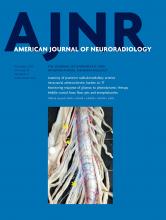Abstract
BACKGROUND AND PURPOSE: Attempts have been made to quantify the microvascular leakiness of glioblastomas and use it as an imaging biomarker to predict the prognosis of the tumor. The purpose of our study was to evaluate whether the extraction fraction value from DSC-MR imaging within nonenhancing FLAIR hyperintense lesions was a better prognostic imaging biomarker than dynamic contrast-enhanced MR imaging parameters for patients with glioblastoma.
MATERIALS AND METHODS: A total of 102 patients with glioblastoma who received a preoperative dynamic contrast-enhanced MR imaging and DSC-MR imaging were included in this retrospective study. Patients were classified into the progression (n = 87) or nonprogression (n = 15) groups at 24 months after surgery. We extracted the means and 95th percentile values for the contrast leakage information parameters from both modalities within the nonenhancing FLAIR high-signal-intensity lesions.
RESULTS: The extraction fraction 95th percentile value was higher in the progression-free survival group of >24 months than at ≤24 months. The median progression-free survival of the group with an extraction fraction 95th percentile value of >13.32 was 17 months, whereas that of the group of ≤13.32 was 12 months. In addition, it was an independent predictor variable for progression-free survival in the patients regardless of their ages and genetic information.
CONCLUSIONS: The extraction fraction 95th percentile value was the only independent parameter for prognostic prediction in patients with glioblastoma among the contrast leakage information, which has no statistically significant correlations with the DCE-MR imaging parameters.
ABBREVIATIONS:
- DCE
- dynamic contrast-enhanced
- EF
- extraction fraction
- Ktrans
- volume transfer constant
- MGMT
- O6-methylguanine methyltransferase
- PFS
- progression-free survival
- Ve
- volume of extravascular extracellular space
- Vp
- volume of vascular plasma space
- IDH
- isocitrate dehydrogenase
- © 2019 by American Journal of Neuroradiology
Indicates open access to non-subscribers at www.ajnr.org












